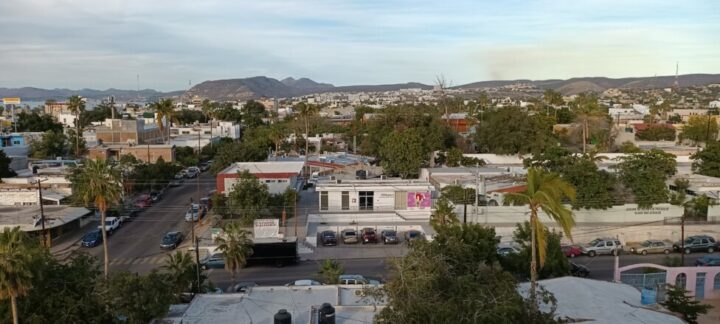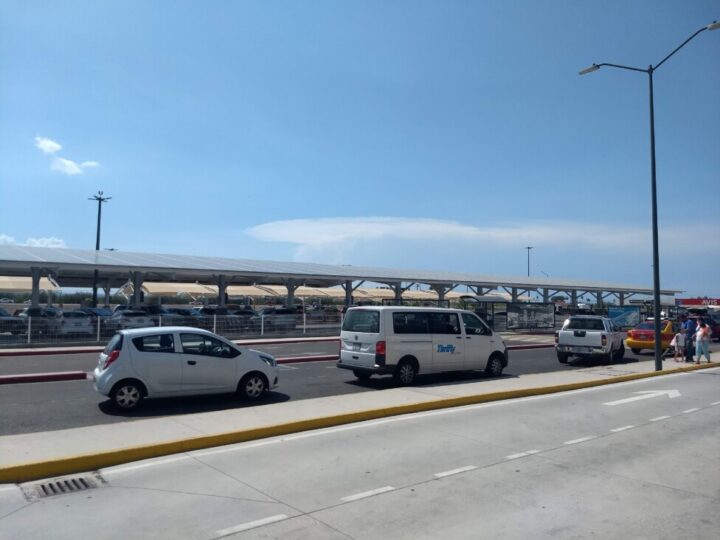
The state-owned Punta Prieta thermoelectric plant generates much of the electricity in La Paz, in the northwestern Mexican state of Baja California Sur, with high economic and air pollution costs. In this and other vulnerable territories in Latin America, access to clean energy is part of the inequality they experience. CREDIT: Emilio Godoy / IPS
By Emilio Godoy
LA PAZ, Mexico , Feb 19 2024 – The specter of blackouts hovers over the Mexican city of La Paz, the capital of the state of Baja California Sur in Mexico’s far northwestern corner, as summer approaches, due to increased electricity demand from air conditioning and insufficient capacity in the local grid.
Since 2019, the local population has suffered the effects of this situation when it starts to heat up in June in this city located 1680 kilometers from Mexico City, which has the additional difficulty of being located in the south of a peninsula that it shares with the state of Baja California.”The location of renewables rarely follows criteria where they are most needed, because the idea is to feed the centralized system. The more rural sectors or those far from cities are not connected to the grid; progress in those areas is slow.” — Gabriela Cabaña
Being separated from the national power grid, due to its distance, Baja California Sur is an energy island whose energy mix depends on thermoelectric plants that burn fuel oil, a very dirty fuel, diesel and gas, while renewable energy contributes about 10 percent. La Paz is where most of the energy is generated, although the highest level of consumption is in the neighboring municipality of Los Cabos, due to its urban growth and insufficient production.
Lucía Frausto, executive director of the non-governmental organization Cómo vamos La Paz, said the model reflects inequities in this city, which had a population of 292,241 according to the last census in 2020.
“The high costs leave no benefits to the community and that impacts everyone. There are sectors that use a lot of energy and others that barely have any. When there are blackouts the water can’t be pumped. It also affects the productivity and competitiveness of businesses,” she told IPS.
The evidence indicates that renewable energy, which is needed to reduce the polluting emissions that overheat the planet, does not address inequality and in some cases foments it.
For this reason, non-governmental organizations and academic groups in Latin America and around the world are pushing for a just transition, understood as an inclusive process, above and beyond mere technological substitution and in line with respect for human rights.
Energy inequality is not just seen in Mexico but extends throughout the Latin American region.
In Latin America and the Caribbean there has been progress in renewable energy, although its impact on inequality is still invisible in the least equitable region on the planet. In addition, almost the entire population has access to electricity, but challenges remain, such as clean energy for cooking and energy efficiency.
The report Fostering Effective Energy Transition 2023, released by the World Economic Forum (WEF), which brings together governments, companies and civil society organizations, warns that the energy transition in Mexico presents a tendency to strengthen inequality.
In this Latin American country, where the energy transition is not moving forward, 15 percent of the population of 129 million lacks access to clean fuel sources in the kitchen and energy efficiency stands at 3.2 percent, below the world average of 4.6 percent. This is part of the persistence of energy inequality, even though poverty fell between 2016 and 2022.
This is reported by the Tracking SDG7: The Energy Progress Report 2023, drawn up by the International Energy Agency, the International Renewable Energy Agency, the United Nations Statistics Division, the World Bank and the World Health Organization.

Population growth in the city of La Paz, capital of the northwestern peninsular Mexican state of Baja California Sur, is also driving the increase in electricity demand in a territory whose supply network is isolated from the national grid and is falling increasingly short. The city is an example of the inequality in access to energy, and especially to alternative sources, in the Latin American region. CREDIT: Emilio Godoy / IPS
Poorly distributed?
Latin America and the Caribbean, a region with 662 million inhabitants, 29 percent of whom live in poverty, have the largest proportion of modern renewable energy use, thanks to hydropower, bioenergy and biofuels.
According to Gabriela Cabaña, a researcher at the non-governmental Center for Socio-environmental Analysis, in most Latin American countries renewable energy is not installed in areas with economic and energy needs, but rather they are in areas privileged by the power grid.
“The location of renewables rarely follows criteria where they are most needed, because the idea is to feed the centralized system. The more rural sectors or those far from cities are not connected to the grid; progress in those areas is slow,” she told IPS from the island of Chiloé, in southern Chile.
In her view, this is a generalized phenomenon in Latin America, where local communities receive the impacts but not necessarily the benefits.
In Chile, the transition shows progress, but there are risks in terms of equity, says the WEF. In that nation, energy efficiency stands at 3.6 percent.
The WEF report says the transition to less polluting forms of energy in Argentina is stable in terms of equity, but local environmental organizations have suffered a major setback under the government of far-right President Javier Milei, in office since Dec. 10.
Moreover, the South American nation reports ups and downs on its path to a low-carbon energy system, and energy efficiency of 3.5 percent.
On the other hand, the transition is inequitable in Brazil, the WEF concludes. In the largest economy and most populous country in the region, with 203 million inhabitants, three percent of the population uses dirty cookstoves, and energy efficiency stands at four percent.
Back in La Paz, Alfredo Bermudez, a researcher at the Department of Fisheries Engineering of the public Autonomous University of Baja California Sur, said the energy scheme in the city has inherited environmental, economic and social consequences.
“La Paz bears the costs and the benefits are not compensated, they are not proportional. There is differential treatment” that is unfair, he told IPS.
Due to local grid congestion, the state can only interconnect 28 megawatts (Mw) and there will be more space perhaps in 2026, which poses obstacles to decentralized solar deployment and illegal connections to the grid.
Official figures indicate that in Mexico there are 367,207 distributed generation permits for 2,954 Mw, figures that have been growing since 2007. In the first half of 2023, 32,223 permits were approved, half of the total for 2022. But Baja California Sur only has 1634 authorizations for 23 Mw, one of the lowest rates in the country.

A photo of solar panels in the parking lot of the airport in La Paz, capital of the northwestern Mexican state of Baja California Sur. The deployment of clean and renewable energies is not, at least for now, a factor in reducing inequality in Latin America; on the contrary, it sometimes fuels it. CREDIT: Emilio Godoy / IPS
The electrified poor
While a minority can finance the installation of solar panels on their homes or drive an electric vehicle, the majority rely on dirty energy or polluting transport.
This gap poses a risk to the fulfillment of the seventh of the 17 Sustainable Development Goals (SDGs), which promotes affordable, clean energy. One of its targets is to “ensure access to affordable, secure, sustainable and modern energy for all,” as part of the 2030 Agenda, adopted in 2015 by the United Nations member states.
In Mexico, the region’s second largest economy, the poorest areas lack renewable energy installations or do not benefit directly from such infrastructure. For example, the southern state of Chiapas, one of the most impoverished in the country, which relies on hydroelectric plants, has only one private wind farm, producing 49 Mw of power. Guerrero, a poor state in the southwest, has no wind farms.
And while Oaxaca, another poor southern state, has the largest installed wind capacity in the country, there are meager benefits for local communities. Oaxaca and Chiapas are among the territories with the fewest distributed generation connections.
In Brazil, Pernambuco in the northeast was the fourth poorest state in 2021 and is one of the largest generators of solar energy, but neither solar nor wind power benefit the population of this and other disadvantaged territories in the country, which in 2023 reached a new record for solar power generation.
In Argentina, population 46 million, the province of Buenos Aires, where the capital is located, has the second largest number of wind turbines, but at the same time has one of the highest poverty rates in the country. A similar phenomenon occurs in the case of solar energy.
In Chile, a country of 19.5 million people, the northern region of Atacama ranks third in solar generation and is a leading wind energy producer in the country, but it also has the second highest poverty rate. .
Improvements
By encouraging the use of computers and the Internet, promoting cleaner forms of cooking and heating or cooling, cleaner energy generates a host of benefits that can have an impact on reducing inequality.
Frausto the activist and Bermudez the academic proposed a greater deployment of renewables and decentralization of generation in Baja California Sur and other energy vulnerable states.
“We need to diversify production and distribution, to have generation throughout the country,” the activist said.
Meanwhile, Bermudez sees an opportunity in the high costs. “You can try things that are not possible in other places, because of the particularities of the state. Anything that reduces costs is advantageous” in electricity generation and efficiency, he said.
Cabaña from Chile recommended public investment to replace private fossil fuel infrastructure.
“We should consider that energy infrastructure should not be in pursuit of a centralized model, but should focus on something more community-based. A change is needed to help combat energy poverty,” she argued.